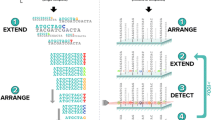Abstract
Balanced complex chromosome rearrangements (CCR) are extremely rare in humans. They are usually ascertained either by abnormal phenotype or reproductive failure in carriers. These abnormalities are attributed to disruption of genes at the breakpoints, position effect or cryptic imbalances in the genome. However, little is known about possible imbalances at the junction points. We report here a patient with a CCR involving three chromosomes (2;10;11) and eight breakpoints. The patient presented with behavioural problems as the sole phenotypic abnormality. The rearrangement, which is apparently balanced in G-banding and multicolour FISH, was shown by genomic array analysis to include a deletion of 0.15–1.5 Mb associated with one of the breakpoints. To explain the formation of this rearrangement through the smallest possible number of breakage-and-reunion events, one has to assume that the breaks have not occurred simultaneously, but in a temporal order within the span of a single cell division. We demonstrate that array comparative genomic hybridisation (CGH) is a useful complementary tool to cytogenetic analysis for detecting and mapping cryptic imbalances associated with chromosome rearrangement.




Similar content being viewed by others
References
Batanian JR, Eswara MS (1998) De novo apparently balanced complex chromosome rearrangement (CCR) involving chromosomes 4, 18, and 21 in a girl with mental retardation: report and review. Am J Med Genet 78:44–51
Batista DA, Pai GS, Stetten G (1994) Molecular analysis of a complex chromosomal rearrangement and a review of familial cases. Am J Med Genet 53:255–263
Borg I, Squire M, Menzel C, Stout K, Morgan D, Willatt L, O’Brien PC, Ferguson-Smith MA, Ropers HH, Tommerup N, Kalscheuer VM, Sargan DR (2002) A cryptic deletion of 2q35 including part of the PAX3 gene detected by breakpoint mapping in a child with autism and a de novo 2;8 translocation. J Med Genet 39:391–399
Carter NP, Fiegler H, Piper J (2002) Comparative analysis of comparative genomic hybridization microarray technologies: report of a workshop sponsored by the Wellcome Trust. Cytometry 49:43–48
Fiegler H, Carr P, Douglas EJ, Burford DC, Hunt S, Smith J, Vetrie D, Gorman P, Tomlinson IP, Carter NP (2003) DNA microarrays for comparative genomic hybridization based on DOP-PCR amplification of BAC and PAC clones. Genes Chromosomes Cancer 36:361–374
Johnson AC, Kageyama R, Popescu NC, Pastan I (1992) Expression and chromosomal localization of the gene for the human transcriptional repressor GCF. J Biol Chem 267:1689–1694
Joyce CA, Cabral de Almeida JC, Santa Rose AA, Correia P, Moraes L, Bastos E, Llerena J Jr (1999) A de novo complex chromosomal rearrangement with nine breakpoints characterized by FISH in a boy with mild mental retardation, developmental delay, short stature and microcephaly. Clin Genet 56:86–92
Knijnenburg J, Szuhai K, Giltay J, Molenaar L, Sloos W, Poot M, Tanke HJ, Rosenberg C (2005) Insights from genomic microarrays into structural chromosome rearrangements. Am J Med Genet 132:36–40
Kumar A, Becker LA, Depinet TW, Haren JM, Kurtz CL, Robin NH, Cassidy SB, Wolff DJ, Schwartz S (1998) Molecular characterization and delineation of subtle deletions in de novo “balanced” chromosomal rearrangements. Hum Genet 103:173–178
Ledbetter DH, Rich DC, O’Connell P, Leppert M, Carey JC (1989) Precise localization of NF1 to 17q11.2 by balanced translocation. Am J Hum Genet 44:20–24
Mitelman F (ed) (1995) ISCN—An international system for human cytogenetic nomenclature. Karger, Basel
Pai GS, Thomas GH, Mahoney W, Migeon BR (1980) Complex chromosome rearrangements. Report of a new case and literature review. Clin Genet 18:436–444
Phelan MC, Blackburn W, Rogers RC, Crawford EC, Cooley NR Jr, Schrock E, Ning Y, Ried T (1998) FISH analysis of a complex chromosome rearrangement involving nine breakpoints on chromosomes 6, 12, 14 and 16. Prenat Diagn 18:1174–1180
Spitz F, Montavon T, Monso-Hinard C, Morris M, Ventruto ML, Antonarakis S, Ventruto V, Duboule D (2002) A t(2;8) balanced translocation with breakpoints near the human HOXD complex causes mesomelic dysplasia and vertebral defects. Genomics 79:493–498
Tanke HJ, Wiegant J, van Gijlswijk RP, Bezrookove V, Pattenier H, Heetebrij RJ, Talman EG, Raap AK, Vrolijk J (1999) New strategy for multi-colour fluorescence in situ hybridisation: COBRA: combined binary ratio labelling. Eur J Hum Genet 7:2–11
Zatz M, Vianna-Morgante AM, Campos P, Diament AJ (1981) Translocation (X;6) in a female with Duchenne muscular dystrophy: implications for the localisation of the DMD locus. J Med Genet 18:442–447
Acknowledgements
This work was partially supported by the “Doelmatigheid” (cost-efficiency) grant from the Leiden University Medical Center (2002/2003), and CR by FAPESP/CEPID (98/14254-2). We thank Peter Pearson and Angela Vianna-Morgante for critical review and suggestions.
Author information
Authors and Affiliations
Corresponding author
Rights and permissions
About this article
Cite this article
Rosenberg, C., Knijnenburg, J., Chauffaille, M.d.L. et al. Array CGH detection of a cryptic deletion in a complex chromosome rearrangement. Hum Genet 116, 390–394 (2005). https://doi.org/10.1007/s00439-004-1248-x
Received:
Accepted:
Published:
Issue Date:
DOI: https://doi.org/10.1007/s00439-004-1248-x




